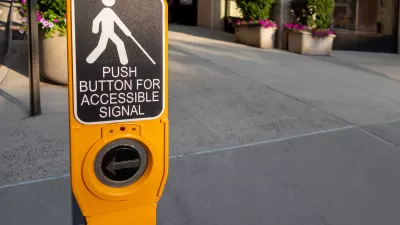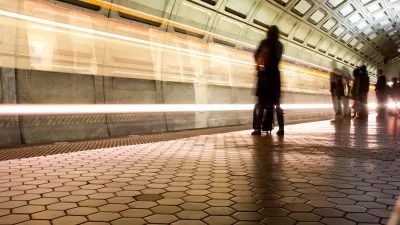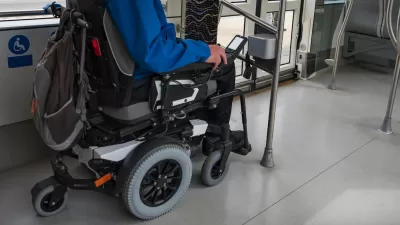Disability rights advocates won a settlement that directs the city to improve accessibility on its public roads over the next 15 years.

The city of Philadelphia will build or repair 10,000 curb cuts to comply with the settlement of a lawsuit filed by disability rights advocates, reports Sophia Schmidt for WHYY. If the settlement agreement is approved by a federal judge, the city will make the required improvements over the next 15 years.
“[The advocates] described a city filled with barriers, including uneven, crumbling sidewalks, improper snow removal, construction without safe alternative routes, illegally parked cars, and ‘fake curb cuts,’ where concrete is just poured to fill the space between the curb and the street,” Schmidt writes. “According to the complaint filed in 2019, several of the plaintiffs had gotten hurt tripping over hazards or falling out of wheelchairs, just trying to get around the city.”
The settlement, which is focused on curb cuts, will not apply to sidewalks or sidewalk obstructions, which pose another challenge to people with disabilities trying to navigate the city.
Although the Americans with Disabilities Act (ADA) is more than three decades old, many public spaces and streets still lack universal accessibility. Meanwhile, private spaces fare no better. As Steve Wright noted in 2020, “In fact, fewer than 1% of single-family homes in America are move-in ready for a wheelchair user, a staggering fact considering that over half of Americans live in single-family houses.”
In 2021, the federal government announced it would enforce the Public Right-of-Way Accessibility Guidelines (PROWAG) as federal standards, which could move the needle on how developers and planners prioritize accessibility. But so far, it has taken lawsuits—in cities such as Atlanta, Baltimore, and Seattle—to gain significant improvements from local governments.
FULL STORY: Philly will build or fix 10,000 curb cuts under settlement with disabled residents

Study: Maui’s Plan to Convert Vacation Rentals to Long-Term Housing Could Cause Nearly $1 Billion Economic Loss
The plan would reduce visitor accommodation by 25,% resulting in 1,900 jobs lost.

North Texas Transit Leaders Tout Benefits of TOD for Growing Region
At a summit focused on transit-oriented development, policymakers discussed how North Texas’ expanded light rail system can serve as a tool for economic growth.

Why Should We Subsidize Public Transportation?
Many public transit agencies face financial stress due to rising costs, declining fare revenue, and declining subsidies. Transit advocates must provide a strong business case for increasing public transit funding.

How to Make US Trains Faster
Changes to boarding platforms and a switch to electric trains could improve U.S. passenger rail service without the added cost of high-speed rail.

Columbia’s Revitalized ‘Loop’ Is a Hub for Local Entrepreneurs
A focus on small businesses is helping a commercial corridor in Columbia, Missouri thrive.

Invasive Insect Threatens Minnesota’s Ash Forests
The Emerald Ash Borer is a rapidly spreading invasive pest threatening Minnesota’s ash trees, and homeowners are encouraged to plant diverse replacement species, avoid moving ash firewood, and monitor for signs of infestation.
Urban Design for Planners 1: Software Tools
This six-course series explores essential urban design concepts using open source software and equips planners with the tools they need to participate fully in the urban design process.
Planning for Universal Design
Learn the tools for implementing Universal Design in planning regulations.
City of Santa Clarita
Ascent Environmental
Institute for Housing and Urban Development Studies (IHS)
City of Grandview
Harvard GSD Executive Education
Toledo-Lucas County Plan Commissions
Salt Lake City
NYU Wagner Graduate School of Public Service





























